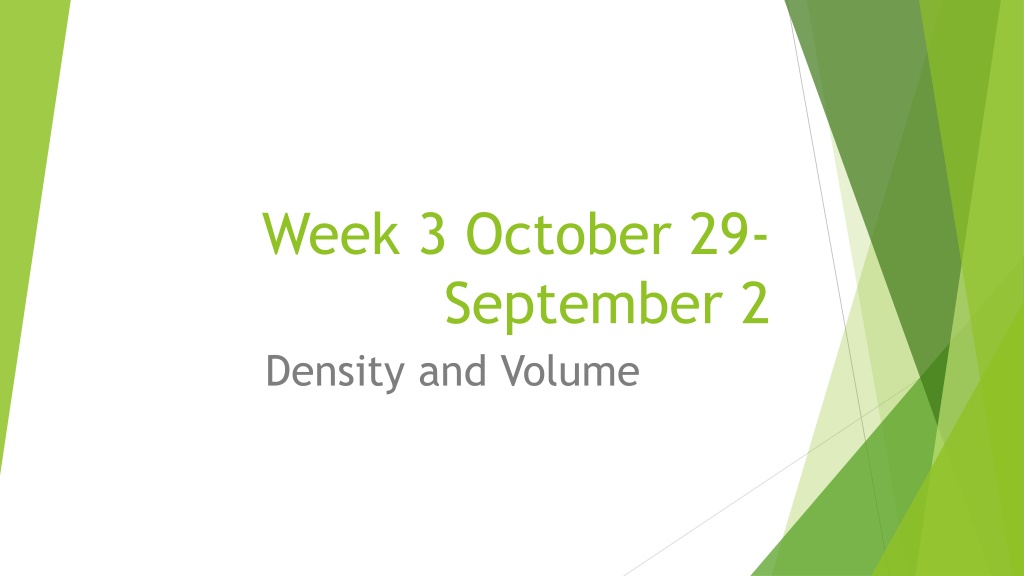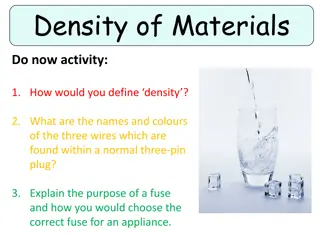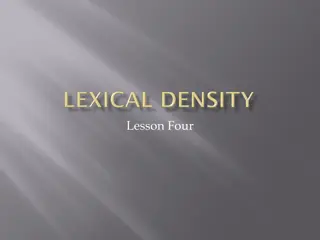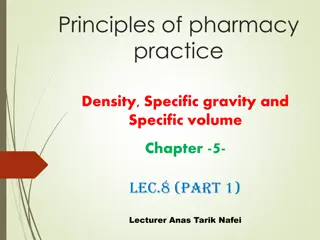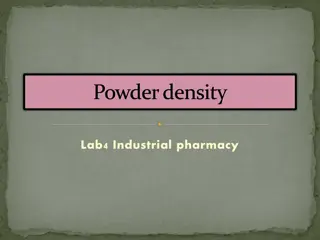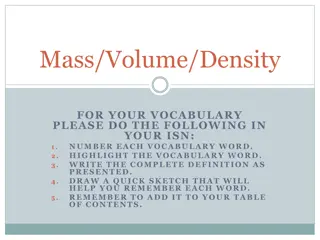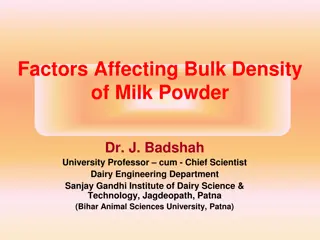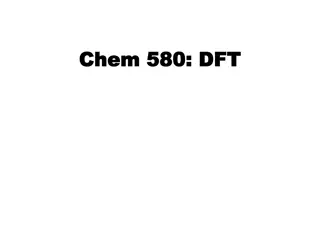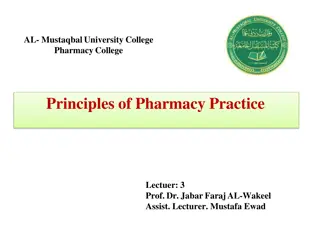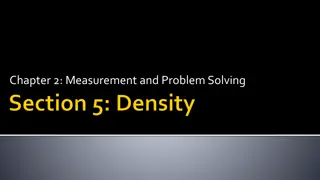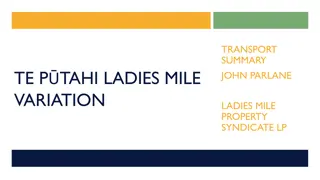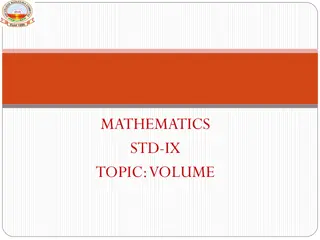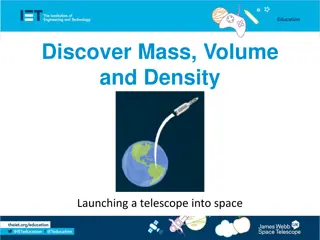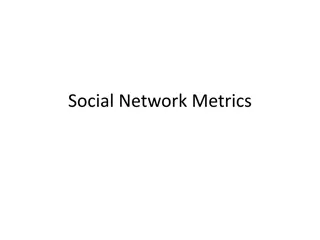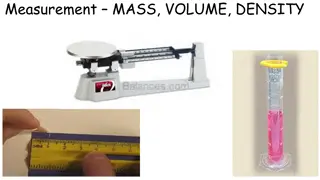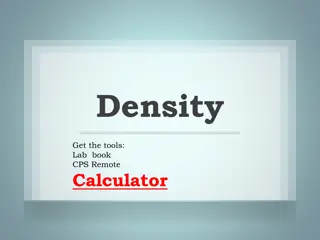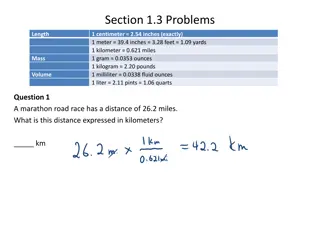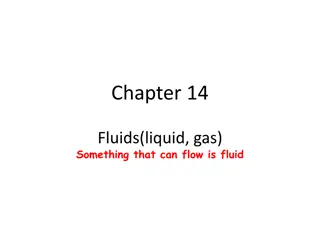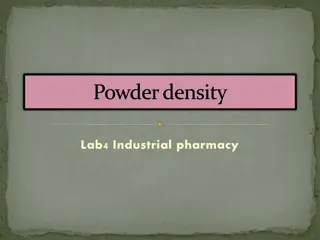Understanding Density and Volume in Science Class
Explore the concept of density and volume in science class through hands-on activities and tests. Learn how to calculate density, mass, and volume, and understand the relationship between volume and mass in solving for density. Practice measuring volume and mass with diverse problems to enhance your understanding. Engage in group activities and assessments to demonstrate your knowledge and skills.
Download Presentation

Please find below an Image/Link to download the presentation.
The content on the website is provided AS IS for your information and personal use only. It may not be sold, licensed, or shared on other websites without obtaining consent from the author. Download presentation by click this link. If you encounter any issues during the download, it is possible that the publisher has removed the file from their server.
E N D
Presentation Transcript
Week 3 October 29- September 2 Density and Volume
Objective Today I will complete my test on density. So that I can demonstrate my gains on bench march SC.8.P.8.3 on density. I know I have it when I can pass my test 8 out of 12.
Density 1 SC.8.P .8.3 C= 0 H= none A= Test M= none, I will collect test P=Looks like students writing down school wide heading and bubbling I.D. number. Set folders up and don t write on test. Wait until test has been picked up. S=8 out of 12
Benchmark SC.8.P.8.3 Explore and describe the densities of various materials through measurement of their masses and volumes. Know Understand Density Mass volume Calculating density, mass and volume Do How density involves the measurement of mass divided by volume Handout: Graduated Cylinder/Measuring Foldable: Temp. and Density Lab: calculate Volume and density Density Practice Homework (Video) column notes 7/7 Homework Online quiz HomeworkFSA p.83,84 Density Practice
Understanding Volume and Mass in Relation to density Today I will practice how to measure volume and mass by calculating diverse problems. So that can explain the relationship volume and mass have with solving for density. I know I have it when I have completed the worksheet and I have answered my
Champs for Todays Lesson C=0 during instruction by teacher or debrief /2 with group H= ask 3 before me A= Volume and Mass Practice M= none P= Looks like students working as a team and attempting to answer assigned questions based on time given. I will check for understanding and correct my answers. S= check for success. Sail fish dollar if you get assigned question correct in the given amount of time.
Handout Graduated Cylinder/Measuring Mass 1) a) 1 mL b) 2 mL c) .2 mL d) .5 mL 2) a) 25 mL b) 37 mL c) 5.5 mL d) 15 ml
Measuring Mass Practice 1. 342.1g 2. 557.2g 3. 285.2g 4. 201.6g 5. 33.1g 6. .6g 7. 356.3g 8. 356.3 gx1000 mg/1 g=356300 mg or since mg is 1000 times smaller move decimal 3 places to right
Measuring Practice 9. 610g 10. .1 g 11) a) 1 Kg b) 3000 kg c) 1 kg d) 7 g e) 3.4 g f) 12 g
Measuring Practice 12. 10 grams 13.2,400 grams a. 2400000 mg 14.1 Kg or 1000 g /1 calculator 200 g = 5 calculator 15.Your pounds lb. = _______ divide by 2.2 lb. 100 lb. x 1 kg/2.2 lb. =
Metric Conversion for Length UNITS OF LENGTH IN THE METRIC SYSTEM 1,000 millimeters (mm) = 1 meter 100 centimeters (cm) = 1 meter 10 decimeters (dm) = 1 meter 1 dekameter (dam) = 10 meters 1 hectometer (hm) = 100 meters 1 kilometer (km) = 1000 meters
Conversion Movement Kg Hg Dag Gram dm cg mg ug Kg King Hg Henry Dag died G/M Monday Dg drinking Cg chocolate mg milk Micro-meter= mucho mucho baby
4 Tab Foldable Looking for Text Evidence C=0 during instruction 2=collaboration H=ask 3 before me A= Foldable M= none P= Looks like students looking for text evidence and sharing with the group in a round robin with group. S=Check for success.
Temperature and Density 4 Tab Foldable Text Even Evidence and Calculate Density and Temperature density of water Temperature Why is density important? p.202 From left to write label the unknown substances? Answer Question 1- 3 in Lesson 2 Check Write 3 details p.201 Answer question 1,2,3 p.203 p.201
Density and Temperature 201 Density is affected by temperature. Most substances become less dense as temperature decreases. Warm air rises and cold air sinks. Water becomes less dense as it becomes warmer but once it is a solid below 40C it becomes less dense.
Temperature and Density of Water p.201 1)When the water is at 40C 2)Since the arrangement of H20 changes and joins in patterns it becomes less compact and causes it to float. https://www.youtube.com/watch?v=UukRgqzk-KE 3)Habitats would be destroyed and ice would remain at the bottom cause damage under water.
Using Density p.202 Density can be use to identify substances. B muscovite A D Gold C Pyrite Biotite 19.37 g/cm3 2.8 g/cm3 3 g/cm3 5 g/cm3
Lesson 2 Check p. 203 120 ml x .75 g/mL=90 grams The cold air mass will sink below the warm air mass. But when this happens the precipitation or storms occur. 150 g
Lab Density C= 0 During instruction and debrief H=ask 3 before me A= Lab M= limited to 2 (helper) P= Looks like students using equipment properly and time efficiently. S=Check for success
Name Date Period Page Lab Volume and Density Essential Questions: How does the displacement water in a graduated cylinder Help with determining density? Questions 1. What is your claim? 2. What is the independent variable? 3. What is the dependent variable? 4. What are some quantitative observations? 5. What are some qualitative observations. 6. Collect the Data: Justify your answer: Notes and Evidence Object 1 g mL d Object 2 g mL d Object 3 g mL d
Check Point 1 ________is measured in grams and doesn t change. Mass _________ is the measure of gravity on an object mass. Weight Weight changes based on _________, on the moon the weight- is smaller position Weight is measure in pounds or Newtons Newtons Since gravity is less on the moon things will tend to _______. float
Check Point 2 _________ is the amount of space an object takes up. Volume Volume always stays the ________. same Volume can be measure by multiplying ______________ length times width times height Volume can be measured by _____________ initial volume final volume called ___________. irregular objects, displacement
Check Point 3 Matter can be solid, _______ and gas and all have volume. liquid Volume can be measured by using a _____________of measuring cup. graduated cylinder __________determines if an object will sink or float Density An object will float if it s density is ___________thank water. less An object will sink if its density is more than water. more
Check Point 4 ________is how light or heavy something is based on it s size. Density Density equals ________/volume mass Matter is anything with mass and __________. volume Matter involves mass, ___________, volume and density weight __________ is the stuff all around us. Matter ___________ is the amount of matter contained in an object. Mass
Keesha measured the mass of the block shown below to be 810 grams (g) Keesha measured the mass of the block shown below to be 810 grams (g). What is the density of the block? The equation d = m/V is used to calculate density. A. 2.7 g/cm3 B. 27 g/cm3 C. 38.6 g/cm3 D. 243,000 g/cm3
Max measures the volume of an irregularly shaped rock as shown below. The density of the rock is 2.2 grams/milliliter (g/mL). What is the mass of the rock? The equation d = m/V is used to calculate density. A. 2.3 g B. 11.0 g C. 18.2 g D. 88.0 g
Julio measured the mass of a small rock as 11.0 grams. Then he measured the volume of the rock as shown in the illustration below. What is the density of Julio s rock? A. 1.1 g/cm3 B. 2.2 g/cm3 C. 5 g/cm3 D. 11 g/cm3
The two cubes on this pan balance have the same size but different masses. What is the volume of each cube? A. 5 cm3 B. 15 cm3 C. 25 cm2 D. 125 cm3
Lianne uses a balance to measure as an irregularly shaped object as shown below. She also measures the volume of the object to be 15.9 cubic centimeters (cm3). What is the density of the object? The equation d = m/V is used to calculate density. A. 0.000 g/cm3 B. 0.127 g/cm3 C. 7.86 g/cm3 D. 1,990 g/cm3
ASSESSMENT Amin had two metal cubes of identical sizes. He placed cube A on one side of a pan balance and cube B on the other side of the balance. The pan that held cube B was now lower than the pan that held cube A. What conclusion can Amin draw about the two cubes? A. The weights of the two cubes are the same. B. The volumes of the two cubes are different. C. The masses of the two cubes are the same. D. The masses of the two cubes are different.
Amin had two metal cubes of identical sizes. He placed cube A on one side of a pan balance and cube B on the other side of the balance. The pan that held cube B was now lower than the pan that held cube A. What conclusion can Amin draw about the two cubes? A. The weights of the two cubes are the same. B. The volumes of the two cubes are different. C. The masses of the two cubes are the same. D. The densities of the two cubes are different.
Which phrase describes the mass of an ice cube? A. amount of space that the ice cube occupies B. estimation of the weight of the ice cube C. total amount of water in the ice cube D. value obtained by multiplying its length times width times height
Paul placed an ice cube into a beaker on a hot plate. The ice cube changed from a solid to a liquid and then to a gas. During this process, which property of the ice cube remained unchanged? A. density B. mass C. temperature D. volume
Which term should Kareem place in the Not Matter column to complete this chart? A. air B. ice C. light D. paper
